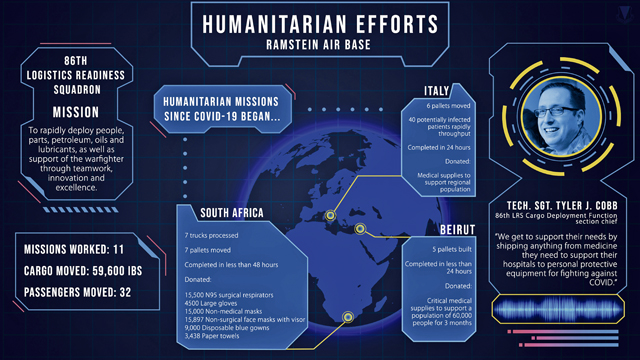What are humanitarian efforts? Are they boxes of food being dropped out of an aircraft? Perhaps people who receive various supplies after a hurricane or an earthquake?
All are correct. Humanitarian efforts are about providing care, a mission with which the U.S. Air Force is more than familiar.
Depending on the level of crisis, the Air Force brings aid; but how does the process of delivering that assistance begin here at Ramstein? After all, such missions require thorough coordination, communication and, most importantly, supplies and personnel.
This is where the 86th Logistics Readiness Squadron spearheads the way.

“Our unit’s mission is to rapidly deploy people, parts, petroleum, oils and lubricants, as well as support of the warfighter through teamwork, innovation and excellence,” said Tech. Sgt. Tyler J. Cobb, 86th LRS cargo deployment function section chief. “More specifically here at the CDF, we’re here to ensure we get the parts and equipment to the warfighter through contingency operations.”
Everything goes through the 86th LRS first. When it comes to humanitarian efforts, supplies for those in need of aid are at the top of the list.
“We get to support their needs by shipping anything from medicine they need to support their hospitals, personal protective equipment for fighting against COVID and working with our NATO allies and coalition partners to support any and all types of humanitarian needs,” Cobb said.
Safety is a top priority and the most compelling evidence for this are the joint inspections, which take place before a flight.
“Here at the CDF, everything gets brought to us, aggregated here, and built up into pallets,” Cobb explained. “We make sure everything is airworthy and safe for flight. The cargo is prepped, then the 721st Aerial Port Squadron will come do the joint inspection and ensure the safety of flight is met whenever we load the aircraft.”
The 86th LRS had the opportunity to exercise their capabilities in support of a humanitarian mission to Lebanon earlier this year.
“Just recently, we supported the U.S. aid to Beirut through this section,” Cobb said. The mission was a quick turnaround, but Cobb and his team met the challenge with gusto.
“My team — they’re outstanding — received the cargo in the afternoon, built [the pallet] from scratch and got all the paperwork generated,” Cobb elaborated. “We were able to get the cargo built and ready for joint inspection that night, then loaded the very next morning.”
Teamwork was an integral part of ensuring this mission was a success. Without the outstanding cohesiveness of the 86th LRS, the mission may have been thrown into disarray. Cobb didn’t worry about it, though.
“I have a great team I work with,” Cobb said with confidence. “They check the mission requirements for the day and upcoming weeks. They ensure we’re prepared for any missions that come down the pipe, scrub the information pushed out from the installation deployment readiness cell and make sure we’re capable of supporting the passengers and cargo that are unit line number tasked to deploy [as well as] the personnel who are supposed to be received by us on the inbound.”
All of this makes it possible for Team Ramstein to support humanitarian efforts. The 86th Logistics Readiness Squadron is part of what keeps the gateway to the world open and ready for anything that may come its way.


